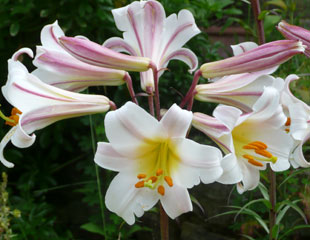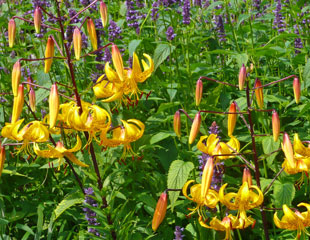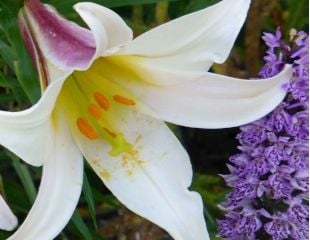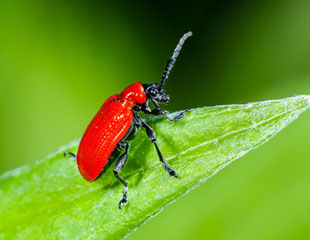


How to Grow Lilies
Key Facts: There are a lot of different types of Lilies. The most commonly cultivated and offered for sale are:
Oriental lilies, illustrated in the second image. These are usually fragrant and prefer acid soil or ericaceous compost. This group includes varieties such as L. Casablanca, Stargazer, and Muscadet, all have many stemmed, large, attractively scented blooms.
Asiatic Lilies Illustrated right the Martagon, Turkscap lily, where the petals recurve, creating a very attractive flower shape. In contrast, these lilies prefer neutral soil, do not have a scent, but have striking flowers.
Many types of lilies often require staking and to be grown in a sunny spot on free-draining soil.
There are many other hybrids, trumpet and Orienpet varieties. The regale lily, illustrated top left and one of the most commonly grown of all lilies, belongs to neither group and is very scented
All Lilies benefit from a feed; tomato food is ideal.
Warning: all parts of the Lily are poisonous to cats, which includes the pollen. This means if a cat brushes against the Lily plant and the pollen transfers to their coat, which the cat then grooms, they can ingest it in this way, which can cause severe illness. Take care when planting.
Apart from Lilies, there are many wonderfully scented garden plants, and I have listed over 20 to choose from.

I have tagged lilies as easy to grow as they are generally pest-free and low maintenance. Providing the soil conditions are right, they will return reliably each year.
How and where to plant Lilies
Lilies grow and flower best in a sunny spot, but they will still do well in light/ dappled shade, planted in well-drained soil. The key points to growing Lilies are to plant in a warm sunny spot and to ensure the soil is well drained.
You can buy and plant lilies either as bulbs or garden-ready pot plants. The most inexpensive way to plant lilies is as bulbs. Growing lilies is possible either in the border or in containers. Lily bulbs are usually planted in the autumn from September to November, and to a depth three times the bulb size, around 10 /15cms deep. If you miss the Autumn planting, lilies can also be planted in the spring, around the end of March/early April. For the best effect, plant lilies in groups of 3 or 5. Lilies do not do as well on heavy soil, especially if you are leaving them in the ground all winter. If your garden has heavy/clay/soil or suffers from winter wet it is better to plant Lilies in a container. As with all bulbs, the flat end with embryo roots points downwards, and the pointed end is at the top.
Some lilies prefer acid soil, and some prefer alkaline. The plant label should help. Broadly, of the most popular varieties, L. Regale prefers neutral or acidic soil, Oriental Lilies are not fussy, and Turkscap will tolerate most with a preference to neutral to alkaline.
All lilies are intolerant of wet soil, which will cause the bulb to rot over winter, and thin dry soil, which will result in a poor show of flowers. All Lilies like a rich soil and will benefit from feeding. During the summer, feed fortnightly with a high potassium feed such as a tomato feed.
After flowering dead deadhead the flowers but leave the foliage in situ to die back naturally and feed the bulb for next year.
How to Grow Lilies in containers
Lilies are a fabulous choice for growing in containers, especially the scented varieties. You can create the perfect growing environment in terms of soil, sun and place the scented varieties of Lily where you can best enjoy them. If your garden soil is not suitable, containers are ideal, and you can place the container in the border if you want to create the illusion that the lilies are growing in the border.
Plant 3 bulbs in a large container in the autumn, or spring. Ensure the compost is suitable for the lily type ( see above). Feed regularly all summer with high potassium feed.
Once it has finished flowering, move the container and let it overwinter in a suitable spot in the garden, with sun. Wet or waterlogged soil will threaten the viability of the bulb. Top dress annually and repot every few years.
Some Lilies are easier to grow than others. Fortunately, the very popular and showy Lilium regale, 1st image top left, will grow in most soils as long as it is not waterlogged. Also easy to grow are Lilium lancifolium, the tiger lily.
Images of Scented Lilies
Scented Pretty Woman

Tall white lily with a soft, sweet Fragrance.
Striped Stargazer lily

A Striped stargazer lily planted with Crocosmia
Lilium Regale scented lily

Nice combination of Lily with wild orchid
How to Get Rid of The Dreaded Lily beetle

The main pest is red lily beetle, which is illustrated and it is a problem when growing lilies, and it will also attack Fritillaria. It is not a native and first arrived in the UK 1939. Lily beetles are bright red, which makes them easy to see. But they are very quick and difficult to catch.
Lily Beetles are about 8mm long and are best controlled by hand. There are pesticides such as Bug Clear, but the non-pesticide way is to pick them off. Unchecked, they will eat the plant. It is necessary either to spray with a bug killer or remove it by a swift crushing with fingers, a bit unpleasant, but effective.
To crush the Lily beetle, you have to be quick. The lily beetle has a party trick to evade predators. It seems to sense your presence, and as soon as it does, it will quickly jump and drop almost to the ground, hiding amongst the plant foliage. The best way is to be quick, spot it, and crush it.
